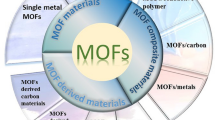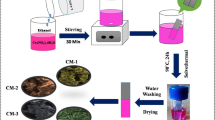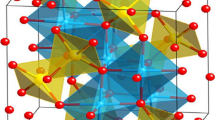Abstract
This article reports the use of crystalline nickel phosphate/carbon fibres (NiPh/CFs) nanocomposite as an electrode material for pseudocapacitor applications. The NiPh particles are synthesised by a cost-effective one-pot method, which is based on refluxing nickel and phosphate precursors at 90 °C. The crystallinity and structural morphologies of the synthesised particles are characterised by X-ray diffraction (XRD) and field-emission scanning electron microscopy (FE-SEM). Also, the N2 adsorption/desorption isotherms are recorded. The Brunauer–Emmett–Teller (BET) method is used to calculate the specific surface area. The electrochemical performances of pristine NiPh and NiPh/CFs composite electrodes are investigated in an alkaline solution of 0.5 M of KOH. The specific capacitances were calculated using cyclic voltammograms at a potential scan rate of 100 mV s− 1. For the pristine electrode, the calculated specific capacitance was 4.3 F g− 1 and for the composite NiPh/CFs electrode, it was 699.2 F g− 1. The significant improvement in the performance is attributed to the high surface area and enhanced electronic conductivity of the NiPh/CFs composite electrode. Also, the composite electrode shows outstanding stability and delivers 1000 cycles with excellent capacitance retention.
Graphical abstract
A cost-effective material for high-performance pseudocapacitors: Crystalline NiPh nanoparticles have been synthesised at 90 °C. SEM image shows the pseudocapacitors composite electrode fabricated by mixing the NiPh with CFs. The electrode delivers a specific capacitance of 699.2 F g−1; calculated from the cyclic voltammogram shown in the figure. Also, the composite electrode shows good stability and provides 1000 cycles with excellent capacitance retention.








Similar content being viewed by others
References
Vatamanu J, Bedrov D (2015) Capacitive energy storage: current and future challenges. J Phys Chem Lett 6:3594–3609
Simon P, Gogotsi Y, Dunn B (2014) Where do batteries end and supercapacitors begin? Science 343:1210–1211
Liang K, Li L, Yang Y (2017) Inorganic porous films for renewable energy storage. ACS Energy Lett 2:373–390
Wen Z, Yeh M-H, Guo H et al (2016) Self-powered textile for wearable electronics by hybridizing fibre-shaped Nanogenerators, solar cells, and supercapacitors. Sci Adv 2:1–8
Aricò AS, Bruce P, Scrosati B et al (2005) Nanostructured materials for advanced energy conversion and storage devices. Nat Mater 4:366–377
Guo Y-G, Hu J-S, Wan L-J (2008) Nanostructured materials for electrochemical energy conversion and storage devices. Adv Mater 20:2878–2887
Yoshio M, Brodd RJ, Kozawa A (2009) Lithium-ion batteries: science and technologies. Springer, Berlin
Simon P, Gogotsi Y (2008) Materials for electrochemical capacitors. Nat Mater 7:845–854
Béguin F, Frąckowiak E (2013) Supercapacitors: materials, systems, and applications. Wiley-VCH, Weinheim
Yu A, Chabot V, Zhang J (2017) Electrochemical supercapacitors for energy storage and delivery: fundamentals and applications
Li P, Li J, Zhao Z et al (2017) A General electrode design strategy for flexible fiber micro-pseudocapacitors combining ultrahigh energy and power delivery. Adv Sci 4:1700003
Conway BE, Birss V, Wojtowicz J (1997) The role and utilization of pseudocapacitance for energy storage by supercapacitors. J Power Sources 66:1–14
Costentin C, Porter TR, Savéant J-M (2017) How do pseudocapacitors store energy? Theoretical analysis and experimental illustration. ACS Appl Mater Interfaces 9:8649–8658
Eftekhari A, Mohamedi M (2017) Tailoring pseudocapacitive materials from a mechanistic perspective. Mater Today Energy 6:211–229
Yang B-J, Jiang L-L, Li Y-J et al (2018) Three-dimensional porous biocarbon wrapped by graphene and polypyrrole composite as electrode materials for supercapacitor. J Mater Sci Mater Electron 29:2568–2572
Shumakovich GP, Morozova OV, Khlupova ME et al (2017) Enhanced performance of a flexible supercapacitor due to a combination of the pseudocapacitances of both a PANI/MWCNT composite electrode and a gel polymer redox electrolyte. RSC Adv 7:34192–34196
Khdary NH, Abdesalam ME, Enany G El (2014) Mesoporous polyaniline films for high performance supercapacitors. J Electrochem Soc 161:63–68
Nejati S, Minford TE, Smolin YY, Lau KKS (2014) Enhanced charge storage of ultrathin polythiophene films within porous nanostructures. ACS Nano 8:5413–5422
Bryan AM, Santino LM, Lu Y et al (2016) Conducting polymers for pseudocapacitive energy storage. Chem Mater 28:5989–5998
Peng Z, Liu X, Meng H et al (2017) Design and tailoring of the 3D macroporous hydrous RuO 2 hierarchical architectures with a hard-template method for high-performance supercapacitors. ACS Appl Mater Interfaces 9:4577–4586
Muniraj VKA, Kamaja CK, Shelke MV (2016) RuO Nanoparticles anchored on carbon nano-onions: an Efficient electrode for solid state flexible electrochemical supercapacitor. ACS Sustain Chem Eng 4:2528–2534
Zeng Z, Liu Y, Zhang W et al (2017) Improved supercapacitor performance of MnO 2 -electrospun carbon nanofibers electrodes by magnetic field. J Power Sources 358:22–28
Vijayakumar S, Nagamuthu S, Muralidharan G (2013) Supercapacitor studies on NiO nanoflakes synthesized through a microwave route. ACS Appl Mater Interfaces 5:2188–2196
Wang W, Guo S, Lee I et al (2014) Hydrous ruthenium oxide nnanoparticles anchored to graphene and carbon nanotube hybrid foam for supercapacitors. Sci Rep 4:4452
Conway BE (1999) Electrochemical supercapacitors scientific fundamentals and technological applications. Springer, New York
Lee HY, Goodenough JB (1999) Brief communication: supercapacitor behavior with KCl electrolyte. J Solid State Chem 144:220–223
Kore RM, Mane RS, Naushad M et al (2016) Nanomorphology-dependent pseudocapacitive properties of NiO electrodes engineered through a controlled potentiodynamic electrodeposition process. RSC Adv 6:24478–24483
Behm N, Brokaw D, Overson C et al (2013) High-throughput microwave synthesis and characterization of NiO nanoplates for supercapacitor devices. J Mater Sci 48:1711–1716
Salunkhe RR, Lin J, Malgras V et al (2015) Large-scale synthesis of coaxial carbon nanotube/Ni(OH)2 composites for asymmetric supercapacitor application. Nano Energy 11:211–218
Zhang Y, Shi Z, Liu L et al (2017) High conductive architecture: bimetal oxide with metallic properties at bimetal hydroxide for high-performance pseudocapacitor. Electrochim Acta 231:487–494
Zhu T, Wang Z, Ding S et al (2011) Hierarchical nickel sulfide hollow spheres for high performance supercapacitors. RSC Adv 1:397–400
Raju K, Ozoemena KI (2015) Hierarchical one-dimensional ammonium nickel phosphate microrods for high-performance pseudocapacitors. Sci Rep 5:17629
Jhung SH, Lee J-H, Cheetham AK et al (2006) A shape-selective catalyst for epoxidation of cyclic olefins: the nanoporous nickel phosphate VSB-5. J Catal 239:97–104
Yang J, Tan J, Yang F et al (2012) Electro-oxidation of methanol on mesoporous nickel phosphate modified GCE. Electrochem commun 23:13–16
Zhan Y, Lu M, Yang S et al (2016) Activity of transition-metal (manganese, iron, cobalt, and nickel) phosphates for oxygen electrocatalysis in alkaline solution. ChemCatChem 8:372–379
Omar FS, Numan A, Duraisamy N et al (2016) Ultrahigh capacitance of amorphous nickel phosphate for asymmetric supercapacitor applications. RSC Adv 6:76298–76306
Yang J-H, Tan J, Ma D (2014) Nickel phosphate molecular sieve as electrochemical capacitors material. J Power Sources 260:169–173
Al-Omair MA, Touny AH, Saleh MM (2017) Reflux-based synthesis and electrocatalytic characteristics of nickel phosphate nanoparticles. J Power Sources 342:1032–1039
Al-Omair MA, Touny AH, Al-Odail FA, Saleh MM (2017) Electrocatalytic oxidation of glucose at nickel phosphate nano/micro particles modified electrode. Electroanalysis 8:340–350
García A, Nieto A, Vila M, Vallet-Regí M (2013) Easy synthesis of ordered mesoporous carbon containing nickel nanoparticles by a low temperature hydrothermal method. Carbon 51:410–418
Cychosz KA, Guillet-Nicolas R, Garcıa-Martınez J, Thommes M (2017) Reporting physisorption data for gas/solid systems with special reference to the determination of surface area and porosity. Chem Soc Rev 46:389–414
Kong L, Chen W (2016) Ionic liquid directed mesoporous carbon nanoflakes as an effiencient electrode material. Sci Rep 5:18236
Umeshbabu E, Rajeshkhanna G, Justin P, Rao GR (2015) Synthesis of mesoporous NiCo2O4–GO by a solvothermal method for charge storage applications. RSC Adv 5:66657–66666
Tammam H, Touny AH, Abdelsalam M, Saleh MM (2018) Mesoporous NiPh/ carbon fibers nanocomposite for enhanced electrocatalytic oxidation of ethanol. J Electroanal Chem 823:128–136
Zhan Y, Lu M, Yang S et al (2016) The Origin of catalytic activity of nickel phosphate for oxygen evolution in alkaline solution and its further enhancement by Iron substitution. ChemElectroChem 3:615–621
Duraisamy N, Numan A, Ramesh K et al (2015) Investigation on structural and electrochemical properties of binder free nanostructured nickel oxide thin film. Mater Lett 161:694–697
Orazem ME, Tribollet B (2011) Electrochemical impedance spectroscopy. Wiley, New York
Acknowledgements
The authors thank the Deanship of Scientific Research at King Faisal University for the financial support (Project Number 186061).
Author information
Authors and Affiliations
Corresponding authors
Rights and permissions
About this article
Cite this article
Abdelsalam, M.E., Elghamry, I., Touny, A.H. et al. Nickel phosphate/carbon fibre nanocomposite for high-performance pseudocapacitors. J Appl Electrochem 49, 45–55 (2019). https://doi.org/10.1007/s10800-018-1279-y
Received:
Accepted:
Published:
Issue Date:
DOI: https://doi.org/10.1007/s10800-018-1279-y




